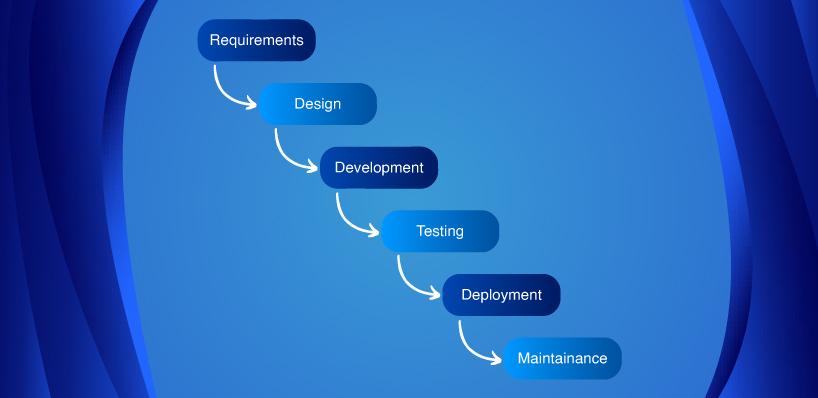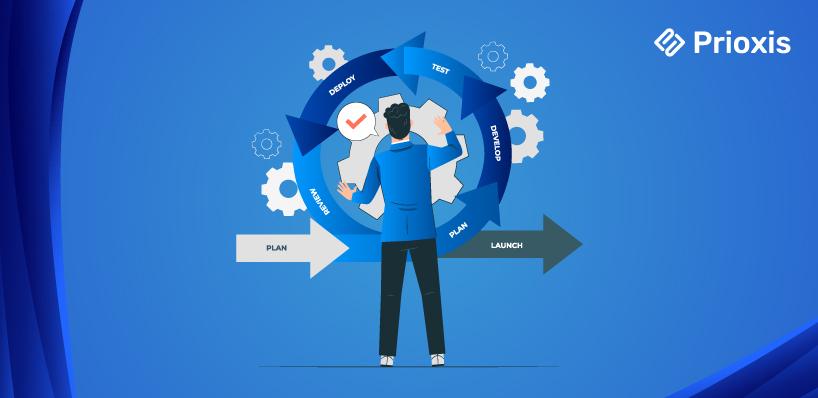Agile vs. Waterfall Project Management Methodology
 Admin
Admin Software Development
Software Development Apr 24, 2024
Apr 24, 2024

Table of Content
What if you had to book an Uber through mail and there was no option available to pay online? You may skip booking it!
But did you know this was how people used to book cabs through Uber in 2010? At that time, Uber was just a web-based transportation app developed using PHP.
However, as Uber started growing, it became difficult to manage requests through email. That's when Uber adopted agile principles and launched a minimum viable product after doing research. And the rest is history. The Agile project management approach helped Uber build the application you see today.
But what exactly is an agile project management approach? To understand it, let’s first understand project management. Project management is a methodology used to manage and execute a project to achieve specific goals within a defined timeframe.
There are 2 most commonly used project management approaches today: waterfall and agile. In this blog, you will learn about them and their pros and cons. You will also find out which framework is best for your project's needs.
Waterfall Project Management
In a waterfall project management approach, each phase of a project is completed before shifting to the next one. The project here follows a linear, sequential process. Thus, the progress flows downward and is divided into different phases.

You cannot go to the second phase without completing the first one.
Key Points to Consider:
- It offers low flexibility
- Completing deliverables before moving on to next phase
- Goals needs to be decided in the beginning
- It requires highly structured team, a hands-on project manager,
Benefits and Limitations of Waterfall Project Management
| Pros | Cons |
|---|---|
| You have a clear idea of your project timelines and when it will get started. Everything is decided between you and the developers. | As one cannot go back to a prior phase in this methodology, you need to provide clear and upfront project requirements. |
| You don't have to look after what is happening in the project constantly. Once the design and project plan are decided, you don't need to constantly supervise the project until the review stage. | If you want a high level of involvement in the project, this may not be a good choice. Because it limits the client's involvement. |
| As each phase of the project needs a deliverable to move on to the next, the workflow is more structured. | The project under this methodology moves slowly, particularly in the initiation stage, as detailed documentation is needed. |
Agile Project Management
In 2001, a group of developers decided to find a methodology that provided more flexibility, resulting in the discovery of Agile principles.
The agile software development approach breaks down the project into different deliverable pieces. Each of these time bound phases is called a sprint and is completed in a few weeks. Teams can also work on each phase concurrently. It focuses on continued delivery that involves customer feedback.

With constantly changing business scenarios, agile principles give flexibility to make changes and iterate during the entire development process.
Key Points to Consider:
- It offers high flexibility.
- It allows constant client involvement
- It has shorter deadlines
- It requires highly adaptable team with team members that can play various roles as needed
Benefits and Limitations of Agile Project Management
| Pros | Cons |
|---|---|
| It enables high adaptability. As it works incrementally, the developers can make changes and adjust accordingly. | The timeline of the project is hard to define from the start and can change frequently. |
| Developers can offer deliverables in order of importance. Le., if a client needs basic software or a minimal viable product like Uber before a full site, it is possible. | The detailed documentation is not available, like in a waterfall, making it difficult to extract details and pass on the same to team members. |
| It is client focused which means the team can keep clients updated about the project progress and also make changes as per the feedback effectively. | This approach requires a high level of collaboration. This is why development projects using this methodology will need a high level of communication. |
Agile vs. Waterfall: Comparison Chart
| Differentiating Factors | Waterfall Project Management | Agile Project Management |
|---|---|---|
| Timeline | It has fixed timing. The entire project flow, including deadlines, is decided before starting the project. | It doesn't have a fixed timeline. Rather, the timeline adapts as the project progresses. |
| Level of Client Involvement | It limits the client's involvement. The requirements are decided upfront during the planning stage, and then the client directly enters the picture during the review stage. | It enables close client involvement. The client can provide constant feedback, and developers can incorporate it into the project. |
| Structure | Waterfall uses a linear and sequential project management practice, with each phase building on the previous one. | Agile principles use an incremental and iterative practice, with the project broken down into smaller pieces. |
| Flexibility | It is rigid. One cannot change the scope of the project once it is defined. | It is more flexible and allows quick changes as and when needed. |
| Budget Requirement | The budget is decided in the beginning as per the requirements and is comparatively less. | As there is the possibility of changes as the project develops, the budget can also change. It usually requires a higher budget than a waterfall |
| Level of Communication | Communication is less frequent and more formal. Roles are allotted to each team member in the beginning, which they cannot deviate from during the entire project. | Communication is more frequent and less formal. The teams are usually self-organizing. This increases the reliance on the team manager for guidance. |
| Time of Delivery | The stakeholders receive the project only once the entire development process is completed | Stakeholders revives deliverables during the entire product development life cycle and not only during the conclusion. |
| Need of Documentation | Each step of the project is documented in detail. | Documentation is less formal. The focus is more on self-organizing teams and collaboration |
Agile vs. Waterfall: Which One is Best for You
The agile and waterfall custom software development methodologies have their own perks and drawbacks. And the decision to select one completely depends on your project's needs. Let’s see which type of project needs which approach to help you make a better decision.
Waterfall Project Management is Appropriate When
- Your project has some strict regulations or requirements. Each phase is documented in detail in waterfall approach, which ensures the requirements are met.
- Small or highly focused projects
- Projects with clear scope and predictable timeline
- Repeatable projects that follow a linear sequence of execution.
Agile Project Management is Appropriate When
- You are uncertain about timeline, budget, and resources of a project
- You have strict time constraints, as agile principles often allow for faster delivery of working software in incremental iterations.
- You need the ability to respond to changes and incorporate feedback throughout the development process
- You desire a high level of client involvement
Choosing the Right Approach Makes All the Difference
Looking at both methods, you may find agile a better option, but remember that not every project is suitable for the same.
If you need more flexibility, complex or changing requirements, high levels of uncertainty, and a need for frequent customer feedback, you can consider being agile. However, in case of well-defined requirements, clear goals, and a need for a more hands-off approach, waterfall is the best.
Thus, the best approach depends on the specific needs and characteristics of your project. If you need help deciding the approach or want a custom software development solution using these methodologies, we can help.
At Prioxis, we have successfully helped many businesses decide and develop projects using these methodologies, and your business can be the next. You can contact us and get a personalized, no obligation session to help you decide which one to go for.
Get in touch
